Pachamanca in Lurin
29 September, 2007, 06:22 pm in "Peru"
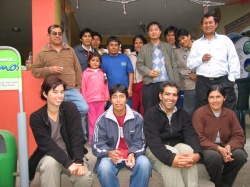 Plans change every instant. We arrived on an overnight bus from Piura, Tepsa, on someone's bad advice. Linea is a much better company but it unfortunately doesn't go direct from Piura to Lima.
Plans change every instant. We arrived on an overnight bus from Piura, Tepsa, on someone's bad advice. Linea is a much better company but it unfortunately doesn't go direct from Piura to Lima. We checked into a hostel, checked the internet, and then set off toward the center to catch the lunch folkloric show at Las Brisas de Titicacca. Minutes after we bought our tickets, Rowhsan called Dennis, the Peace Corps Volunteer in Lurin, who Chris, a PCV we met at the lodge in Huaraz had put us in touch with. (I'm getting the feeling I've been hanging out with more PCVs in Peru than I did when I was in the Peace Corps in Russia!) It turned out that the artists of Ichimay Wari were having a lunch event for several groups of touists featuring pachamanca, a traditional Peruvian dish of meat, chicken, potatoes, sweet potatoes, corn, tamales and beans, all cooked together in an earthen firepit with hot rocks.
We cancelled our reservations at Las Brises and hopped on a bus to Lurin. Dennis met us at the bus stop and led us to the Ichimay Wari space. There was a large concrete sports area that had a tent with people eating and dancers performing.
"It looks like they've started eating already. I hope there's food left!" Dennis said as we hurried into the building quickly being introduced to some of the artists on the way. There was still plenty of food and we ended up iwth large platefulls. The pachamanca was tasty. The meat was spicy and there was a hot pepper sauce that went with everything. Little cups containing Pisco sours were passed about. I had a sip. It was pretty good. The food was delicious.
After we finished we mingled a bit. Earlier we had been shown the gallery (while we were waiting for our plates to be prepared). There were lots of wonderful pieces: ceramics, retablos and woven tapestries.
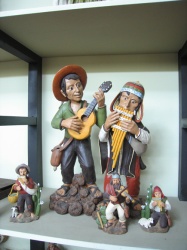
One of the women there who spoke some English, led me outside to watch a dance and almost immediately we were pulled into it. After lunch was over we visited Maurelio's (one of the ceramic artists) studio. He answered Rowshan's questions (Dennis translated) and showed his clay and gazes as well as some of the different pieces. Most of the pieces being worked on were for an order so they were made from molds (which Maurelio had created from his original pieces). Dennis talked about how they are trying to work out a way to copyright the artist's designs since it is a big problem that artists like Maurelio would work hard to create an original piece and then other "artists" would rip off the designs. Apparently it has gotten so bad that some of the artists don't want to show new pieces they have worked for a long time on for fear of them being copied.
Rowshan will be studying ceramics with Maurelio in a week and we'll be staying with him and his family.
After that we went back to the Ichimay Wari space and had more Pisco sours and some desert. A pudding that reminded me of Turkish asura (Noah's Pudding). Then we headed over to Donato's studio. Donato makes retablos, wooden boxes containing scenes with figures made from flour paste.
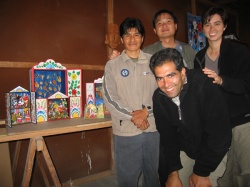
First he showed us a room where his wife was working painting. He showed us some of the paste and the molds (his originals) that he used. Dennis had mentioned that one of the terrible things about the earthquake was many of the artists had their molds broken. The main room wasfilled with pieces that were mostly mass produced for customers. However, in the next room Donato, had his fine art pieces. These were amazing detailed Retablos. One was of a fiesta with lots of musical instruments and people playing music.
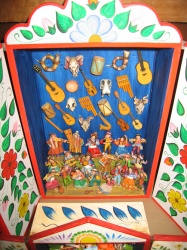
One was a Peruvian annunciation scene with the angel and Mary in Peruvian attire. They were like looking at 3-D miniature paintings with careful color and detailed features. We felt really honored to see these pieces in the artist's studio.
Back at Ichimay Wari we were treated to more Pisco sours, joking and photos.
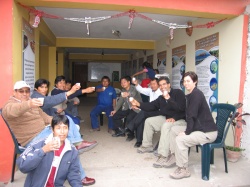
It was a fabulous afternoon and we learned the word for "drunk" in Quechua. The artists in Ichimay Wari mostly came to Lurin from Ayacucho during the 80s fleeing political problems and terrorism in the region. They are continuing the traditional arts of Ayacucho in Lurin. Tours of the artists' studios are available by contacting Ichimay Wari for anyone reading this who would like to see some of the finest examples of traditional Ayacuchan arts.
While we were wondering around Miraflores area, we stumbled on Emilio´s shop who does amazing woven tapestries.
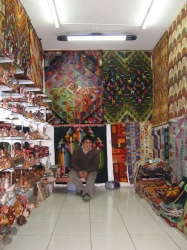
Comments
- Comments
Powered by My Blog 1.69. Copyright 2003-2006 FuzzyMonkey.net.
Created by the scripting wizards at FuzzyMonkey.net..
(Code modified by Rowshan Dowlatabadi)
Created by the scripting wizards at FuzzyMonkey.net..
(Code modified by Rowshan Dowlatabadi)

